As a Matter of Finance
Finance & Development, March 2013, Vol. 50, No. 1
Adolfo Barajas and Ralph Chami
To help boost economic growth, Arab countries need a stable supply of funds and better access to credit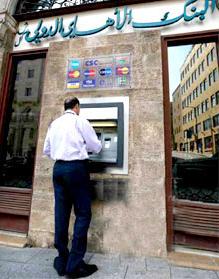
The Arab Spring ushered in a dawn of change across many countries in the Arab world. Discontent drove the demonstrations, and later the discourse. Now a new world has begun to develop in a number of countries still in varying states of transition.
Though it is still too early to reach definitive conclusions as to what drove the awakening across the Arab world, it is quite clear that the pace and quality of economic growth in the Middle East and North Africa (MENA) for several decades lagged far behind that of other developing economies (see Chart 1) and failed to deal with socioeconomic inequalities that fueled social tensions.
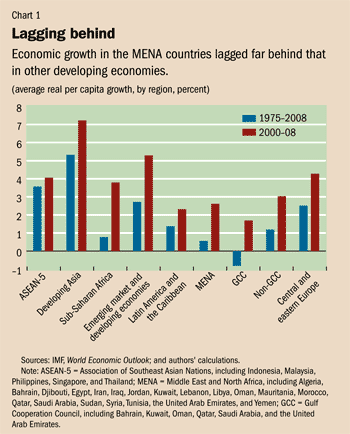
Although it has picked up since 2000, economic growth in the region is still lackluster and therefore of significant concern to policymakers. Several studies have uncovered a number of contributing factors, including subpar institutional quality, the difficulty of doing business, high rates of government spending, and lack of trade openness.
More recently, the limited effectiveness of the financial sector has been identified as an additional factor holding back long-term growth. By taking stock of the current state of finance following the Great Recession and reviewing its role in promoting growth, a picture begins to emerge of the challenges facing MENA countries when it comes to the promotion of financial development.
Emerging from boom and bust
Like much of the world, MENA countries experienced a marked acceleration in bank lending beginning in the mid-2000s. Until 2008, banking systems in most of these countries expanded credit to the private sector at a very rapid pace, often far above the rate of growth of the real economy. Recent analytical work found that eight countries in the MENA region were in the midst of a credit boom at some point around 2008, in the sense that the ratio of credit to GDP had surpassed the historical trend by an extraordinary margin (Barajas and others, 2011). At the same time, the region as a whole, along with sub-Saharan Africa and central and eastern Europe, was experiencing a generalized credit boom.
But with the global chain of events unleashed by the Lehman Brothers failure in September 2008, the ensuing drying up of funds—both domestic and foreign—contributed to equally spectacular declines in the growth of credit. For example, after peaking at over 26 percent in mid-2008, credit growth in Bahrain slowed to just over 4 percent by the first quarter of 2010. In Jordan, credit growth plunged: it grew faster than 14 percent in 2008 but contracted by 2 percent in the first quarter of 2010. This general pattern was observed in most of the region, more markedly among oil exporters and in the high-income Gulf Cooperation Council (GCC) countries in particular.
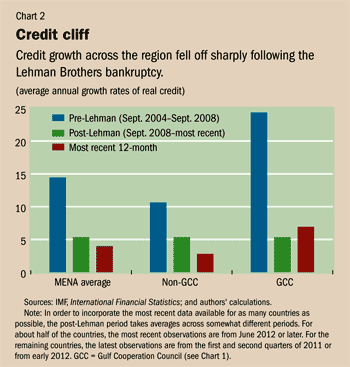
More recently, although credit growth has certainly been picking up from its postcrisis lows, the recovery from the boom-bust cycle is still incomplete. Based on the typical behavior observed during previous boom-bust cycles in the region over the past two and a half decades, the above-mentioned study suggests that it would take at least three years to return to “normal” growth rates, in the range of 5 percent a year. Indeed, as of 2011 and early 2012, which is when the latest observations are available for various countries, average postcrisis credit growth in the region had declined by some 10 percentage points compared with the four-year period before 2008, and the latest observed 12-month growth rate is approaching 4 percent on average (see Chart 2). Partly owing to heightened uncertainty and disruptions in economic activity resulting from the political transitions of the Arab Spring of 2011, credit is more subdued in the non-GCC countries, growing by less than 3 percent annually.
Stable systems
A notable positive aspect of banking systems in the MENA region is their lower propensity for widespread instability when compared with other regions. This applies not only to the recent boom-bust cycle, but over a longer period as well. A study by Laeven and Valencia (2012) identifies systemic banking crises throughout the world as events during which widespread bank runs, bank losses, or liquidations combine with large-scale crisis intervention measures. Their analysis reveals a strikingly low frequency of these events in MENA countries throughout the past four decades.
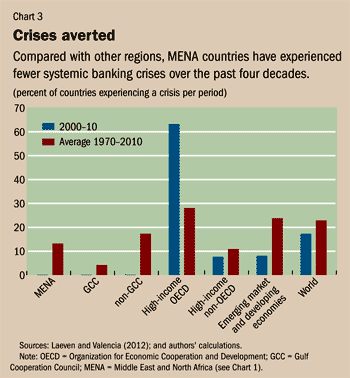
Between 1970 and 2010, the region experienced systemic banking crises about 13 percent of the time, compared with 22 to 23 percent of the time for the world and for emerging market and developing economies as a whole, respectively (see Chart 3). What’s more, during 2000–10, crises erupted to an unprecedented degree in member countries of the Organization for Economic Cooperation and Development—more than 60 percent of these countries were in crisis at some point during this period—but the MENA region as a whole managed to avoid such crises entirely. Note that emerging market and developing economies in general were not immune to crisis in this recent period: they experienced such episodes about 8 percent of the time.
More than meets the eye
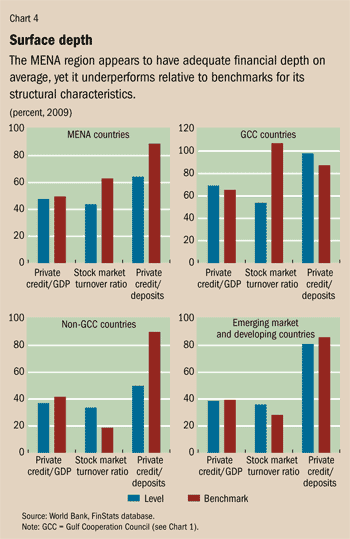
Notwithstanding the boom-bust cycle described above, the MENA countries have experienced several decades of steady, if unspectacular, financial deepening—that is, increasing importance of the financial sector in the economy. As a result, as of 2009 the region comes out rather favorably compared with other regions of the world, albeit with some caveats that are not immediately evident from the aggregate figures (Barajas, Chami, and Yousefi, 2011). Using standard measures of depth in banking (ratio of private sector credit to GDP) and stock markets (market turnover or ratio of value traded to GDP), it appears that financial development is quite adequate in the MENA region, amply surpassing the averages in other emerging market and developing economies (see Chart 4).
The first caveat, however, is that beneath the aggregate figures lies considerable variability across countries within the region. For example, in 2009 private sector credit amounted to 78 percent of GDP in Jordan, almost eight times the level observed in Libya. Similarly, stock market turnover in Saudi Arabia, at 199 percent, was about 11 times that of Lebanon.
The second qualification is that, while the capacity of MENA economies to generate deposits has been quite substantial, the intermediation of those funds by banks into private sector credit has not been as impressive. MENA banking systems are more likely to send funds abroad or invest in domestic securities—government bonds, for example—than increase credit one-for-one with additional deposits received.
By expanding on these underlying issues and comparing financial depth, not only with that of other regions, but also in relation to structural characteristics of the economy, we can draw more meaningful conclusions. Recognizing that a country’s financial development may be partly explained by structural factors such as its income, population size and density, age distribution, and whether it is an oil exporter or offshore financial market, the World Bank has produced financial depth benchmarks against which a country’s level of financial development may be compared at different points in time (Al-Hussainy and others, 2011). Simply put, the benchmark indicates the degree of depth that would be expected from a country with given structural characteristics.
This comparison reinforces our earlier discussion. As of 2009—the most recent year for which structural benchmarks have been estimated—MENA countries had an average credit-to-GDP ratio of 48 percent and a stock market turnover ratio of 45 percent, both about 10 percentage points above the average for emerging market and developing economies as a whole (see Chart 4).
For the world as a whole, the average level of a given indicator should be equal to the level predicted by the average structural characteristics. However, this does not necessarily hold for individual countries or regions, which may under- or outperform their benchmarks. Although banking systems in emerging market and developing economies, on average, had roughly the amount of private sector credit that would be expected from their structural characteristics—actual ratios of credit to GDP and credit to deposits being roughly equal to the respective benchmarks—MENA banking systems underperformed.
The underperformance was most notable in the non-GCC countries and with respect to the credit-deposit ratio, which indicates the inability to convert deposit funds into private sector loans. Indeed, the MENA credit-deposit ratio was 18 percentage points below its structural benchmark, and in the non-GCC countries it was 40 percentage points below (see Chart 4). This is partly due to heavy public sector borrowing, particularly in certain non-GCC countries. For example, in Algeria, banks lend almost 50 percent more to the government than to the private sector, in Syria over 20 percent more, and in Egypt roughly the same amount as to the private sector. On average, MENA banking systems lend close to 13 percent of GDP to the government and to state-owned enterprises. Regarding stock market activity, turnover appears at first glance to be relatively robust in the MENA region, yet the high level observed in the GCC countries reaches only about half its structural benchmark.
Improving access
A final caveat concerns the region’s ability to generate access to finance commensurate with its financial deepening, a point emphasized in World Bank (2011). Despite the important strides made by MENA countries to reform their business environments and deepen their financial markets, the region still ranks lower than any region except sub-Saharan Africa in access to both deposits and bank loans. Moreover, available credit tends to be heavily concentrated, favoring a few large and well-established firms, while smaller and young businesses—those that create the majority of jobs—are left to rely on limited internal finance or informal channels to secure much-needed funds.
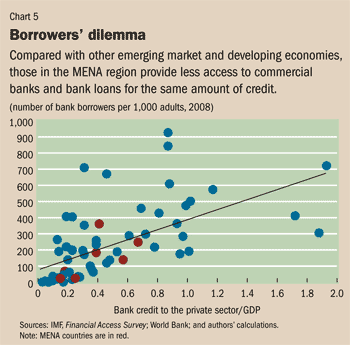
Furthermore, MENA countries fall short on access to credit not only relative to other regions but also relative to the depth of credit. For example, almost invariably, the population’s use of bank loans falls below that in other countries with similar ratios of private sector credit to GDP (see Chart 5).
Previous IMF research found that a given level of banking depth in MENA countries is less effective than in other regions when it comes to generating economic growth over the long term—an indication of a quality gap in MENA banking systems. Although it is difficult to ascertain exactly why the same amount of bank credit in MENA countries pays a weaker growth dividend than in other regions, it is quite plausible that limited access to credit and to financial services in general is a key piece of the puzzle, and may in part explain the persistent underperformance of MENA countries in economic growth.
Depth is not enough
The MENA region is at a historic juncture. Beyond the challenges of political transition, the economic objectives are quite clear: raise the rate of economic growth, create more jobs, and ensure that economic growth is more inclusive. It is also clear that financial stability alone is not enough for the region to enjoy the benefits of economic growth and that there is a dire need for inclusive financial deepening. Achieving this objective depends on a comprehensive agenda covering sound economic policies as well as far-reaching structural and institutional reforms.
A successful reform agenda for the coming years will necessarily be a balancing act. Increasing depth—in countries that are still lagging—and enhancing access to the existing depth will require a combination of market-friendly policies that remove distortions, such as barriers to entry, interest and credit controls, and direct state ownership of banks, as well as substantial pressure to finance the government. In addition, broader policies aimed at improving the environment for financial intermediation should be pursued: macroeconomic stability must be maintained, legal protection of creditor and small shareholder rights must be strengthened, and credit information and collateral regimes must be enhanced. Naturally, as credit increases in size and breadth throughout these economies, and the borrower pool expands beyond the traditional large and well-connected firms, credit risk is likely to rise. Policymakers should ensure that market-harnessing policies, both at the micro- and macroprudential levels, are up to the task, so that the gains achieved by greater finance are not undone by excessive instability.
Adolfo Barajas is a Senior Economist in the IMF’s Institute for Capacity Development, and Ralph Chami is a Division Chief in the IMF’s Middle East and Central Asia Department.
References
Al-Hussainy, Ed, Andrea Coppola, Erik Feyen, Alain Ize, Katie Kibuuka, and Haocong Ren, 2011, “FinStats 2011: A Ready-to-Use Tool to Benchmark Financial Sectors Across Countries and Over Time” (Washington: World Bank).
Barajas, Adolfo, Ralph Chami, Raphael Espinoza, and Heiko Hesse, 2011, “ Further Fallout from the Global Financial Crisis: Credit Crunch in the Periphery,” World Economics, Vol. 12, No. 2, pp. 153–76.
Barajas, Adolfo, Ralph Chami, and Reza Yousefi, 2011, “The Impact of Financial Development on Economic Growth in the Middle East and North Africa,” Chapter 3.3, Regional Economic Outlook: Middle East and Central Asia (Washington, April).
Laeven, Luc, and Fabián Valencia, 2012, “Systemic Banking Crises Database: An Update,” IMF Working Paper 12/163 (Washington: International Monetary Fund).
World Bank, 2011, MENA Financial Sector Flagship Report (Washington).


